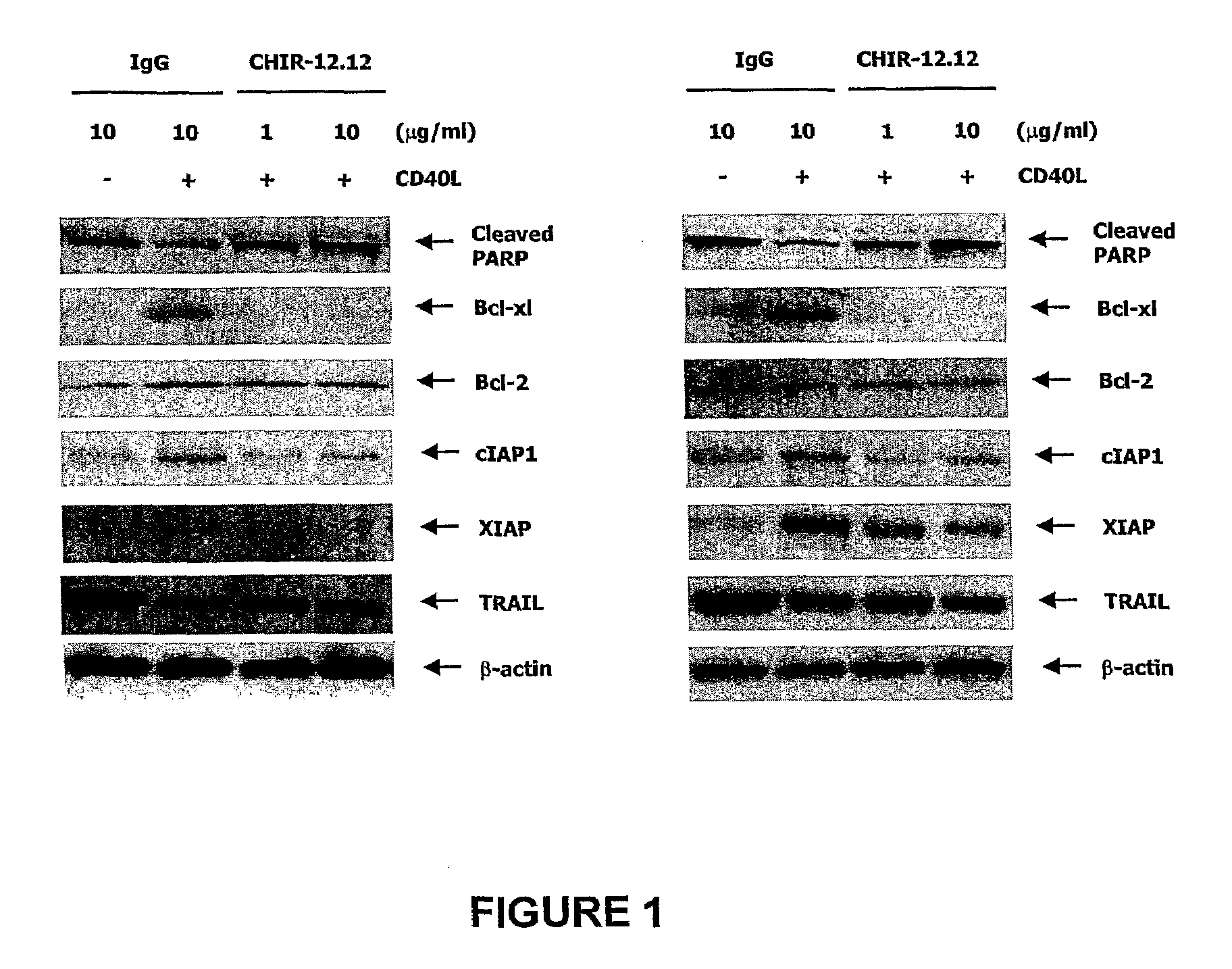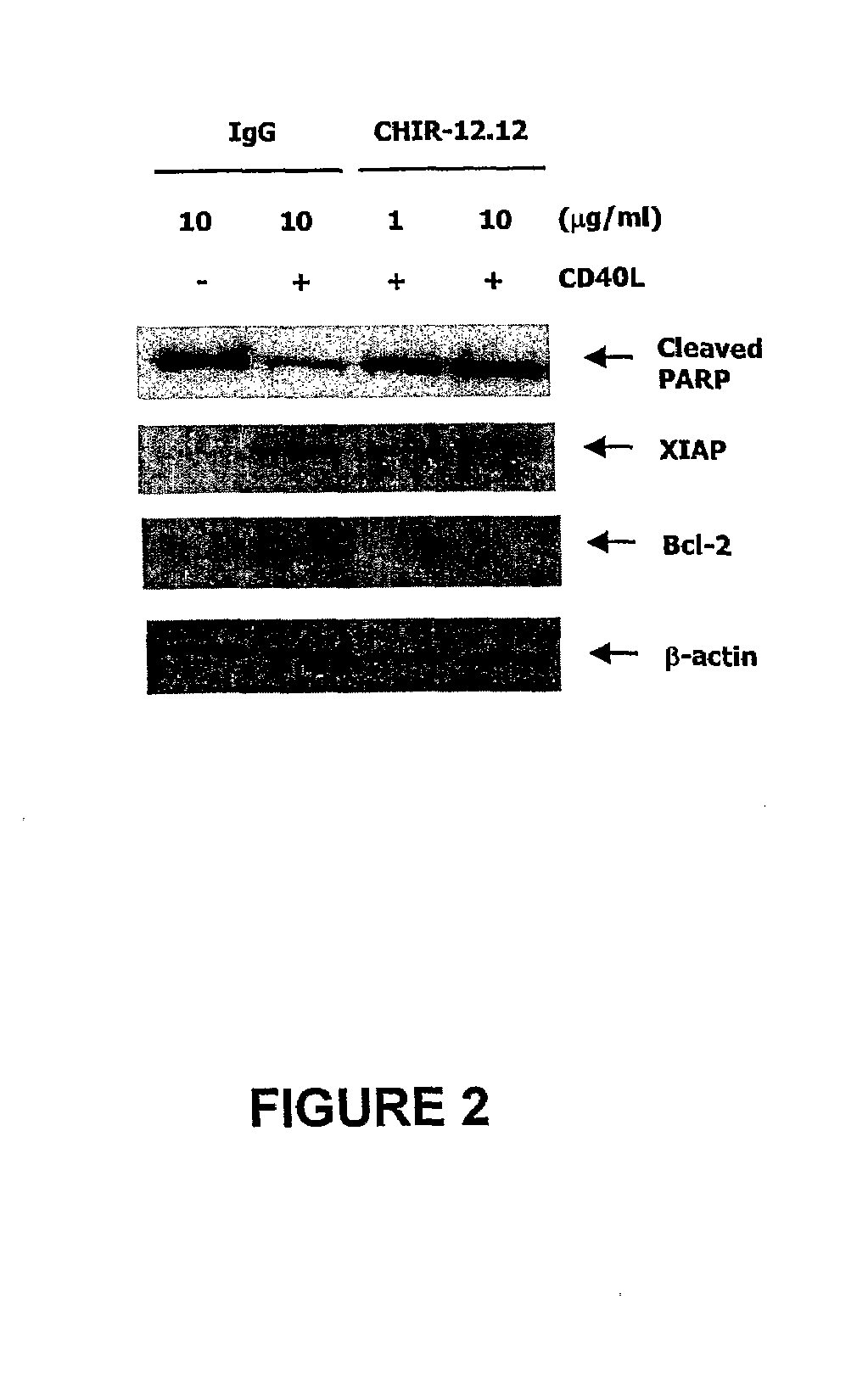Methods for diagnosis and treatment of proliferative disorders mediated by cd40 signaling
- Summary
- Abstract
- Description
- Claims
- Application Information
AI Technical Summary
Benefits of technology
Problems solved by technology
Method used
Image
Examples
example 1
CHIR-12.12 Blocks CD40L-Mediated CD40 Survival and Signaling Pathways in Human B-CLL Cells
[0236]The studies described below demonstrate that CHIR-12.12 also directly inhibits survival and signaling pathways mediated by CD40 ligand (CD40L) in B-CLL. CD40L activates B-lymphocytes and induces various functional responses, including enhancement of survival, and activation of NFkB, ERK / MAPK, and PI3K / Akt signaling pathways. In addition, CD40L stimulation provides survival signals demonstrated by reduction of cleaved PARP and induction of the antiapoptotic proteins, Bcl-xl, XIAP, and cIAP. In contrast, treatment of CD40L stimulated B-CLL with CHIR-12.12 resulted in induction of cleaved caspase-3 and cleaved PARP as well as reduction of Bcl-xl, XIAP, and cIAP in a time- and dose-dependent manner. CHIR-12.12 alone did not trigger apoptosis without CD40L stimulation. We examined signal transduction events induced by CD40 activation with its ligand. The engagement of CD40 with CD40 ligand led...
example 2
Ability of Anti-CD40 mAb CHIR-12.12 to Lyse Multiple Myeloma (MM) Cell Lines by Antibody-Dependent Cellular Cytotoxicity (ADCC)
[0260]Human MM cell lines, KMS-12-BM, IM-9, and ARH-77, were washed 3 times using R2 medium (Pheno red-free RPMI with 2% FBS) and re-suspended in R10 medium (Pheno red-free RPMI with 10% FBS) at the density of 1×106 / mL. Cells were labeled by adding Calcein AM (final concentration 5 mM) and incubating for 30 minutes at 37° C. in a humidified atmosphere with 5% CO2. Purified human NK cells and Calcein-labeled target cells were mixed in R10 medium at the ratio of 10 to 1 (5×104 NK cells and 5×103 target cells in 200 mL) and added in U-bottom 96 well plate (Packard's Instrument, Meriden, Conn.). CHIR-12.12 was serial diluted at desired concentration and added in triplicates into the wells containing NK / target cell mixture. 1% NP-40 was added in 3 wells for the maximum cell lysis. Cells were incubated for 4 hours without disturbance at 37° C. in a humidified atmo...
example 3
CHIR-12.12 Anti-Tumor Activity in Multiple Myeloma Animal Models
[0262]When administered intraperitoneally (i.p.) once a week for a total of 3 doses, CHIR-12.12 significantly inhibited the growth of multiple myeloma tumors in several tumor models in a dose-dependent manner. When CHIR-12.12 was combined with bortezomib (VELCADE®) the efficacy observed was additive.
IM-9 Multiple Myeloma Xenograft Model
[0263]SCID mice were inoculated subcutaneously with IM-9 tumor cells (a human multiple myeloma cell line expressing both CD40 and CD2O) in 50% MATRIGEL™ at 5×106 cells per mouse. In the first study, tumor-bearing mice were injected intraperitoneally with control IgG1 at 10 mg / kg, CHIR-12.12 anti-CD40 mAb at 1 mg / kg, or CHIR-12.12 anti-CD40 mAb at 10 mg / kg on days 5, 12, and 18 after tumor implantation. Alternatively, bortezomib dosing at 1 mg / kg intravenously occurred on days 5, 8, 12, and 15 after tumor implantation. In the second study, tumor-bearing mice were injected with control IgG1...
PUM
| Property | Measurement | Unit |
|---|---|---|
| Mass | aaaaa | aaaaa |
| Fraction | aaaaa | aaaaa |
| Fraction | aaaaa | aaaaa |
Abstract
Description
Claims
Application Information
 Login to View More
Login to View More - R&D
- Intellectual Property
- Life Sciences
- Materials
- Tech Scout
- Unparalleled Data Quality
- Higher Quality Content
- 60% Fewer Hallucinations
Browse by: Latest US Patents, China's latest patents, Technical Efficacy Thesaurus, Application Domain, Technology Topic, Popular Technical Reports.
© 2025 PatSnap. All rights reserved.Legal|Privacy policy|Modern Slavery Act Transparency Statement|Sitemap|About US| Contact US: help@patsnap.com



